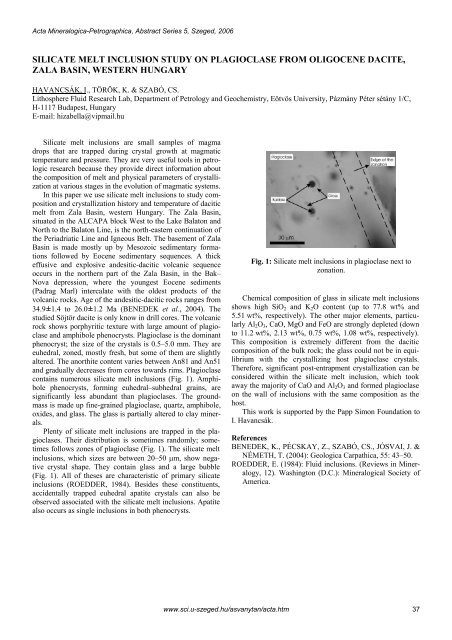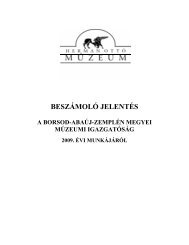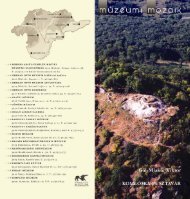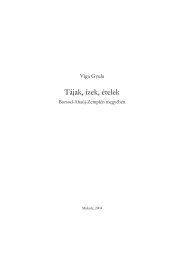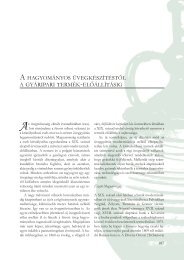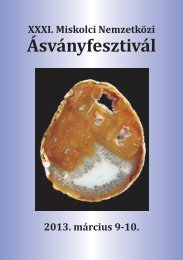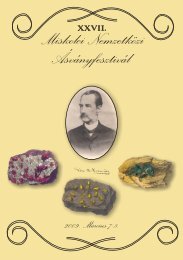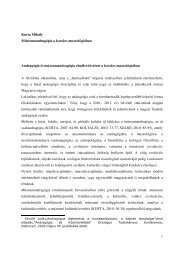Acta Mineralogica-Petrographica, Abstract Series 5, Szeged, 2006CATHODOLUM<strong>IN</strong>ESCENCE MICROCHARACTERIZATION OF ILLITE FROMFÜZÉRRADVÁNY, NE HUNGARYGUCSIK, A. 1 , N<strong>IN</strong>AGAWA, K. 2 , NISHIDO, H. 2 , OKUMURA, T. 2 , BIDLÓ, A. 1 , KOVÁCS, G. 1 , HEIL, B. 1 &PATOCSKAI, Z. 11 Dept. of Soil Sciences, University of West Hungary, Bajcsy Zs. E. u. 4., H-9400 Sopron, HungaryE-mail: ciklamensopron@yahoo.com2 Dept. of Applied Physics, Okayama University of Science, Ridai-cho 1-1, Okayama, 700-0005, JapanThe purpose of this study is to contribute to the structuralcharacterization of illite by the application of the cathodoluminescencetechnique.The operating conditions for all SEM-CL investigation aswell as SEM and backscattered electron (BSE) microscopywere accelerating voltage: 15 kV, and 1.0 nA at room temperature(MARSHALL, 1988; IKENAGA et al., 2000). CLspectra were recorded in the wavelength range of 300-800nm, with 1 nm resolution by the photon counting methodusing a photomultiplier detector, Hamamatsu PhotonicsR2228.The SEM images, especially secondary electron images,(SEI) of illite from Füzérradvány show individual grains withhighly altered or damaged rim structures. The core of thesegrains does not contain any cracks or other mineral phases.The pore spaces are relatively low. In general, mostly hexagonalgrains are separated by fractures, which occur in variablewidths between 1 and 10 µm (Fig. 1A). CL image ofillite shows relatively bright, crystallographically controlledbands and zones in the otherwise CL-dark background. TheCL-bright patchy areas and spots in the CL images may berelated to the quartz impurity. The presence of minoramounts of quartz was indicated by XRD analyses of theillitic raw material. The presence of quartz may also be expectedfrom the extensive silification of the area as revealedby the geological exploration (CSONGRÁDI et al., 1996).The CL-dark background of these images is due to lack of therecombination centers or electron traps producing the nonluminescentnature of the CL emission in the illite samples.The low intensity might also be caused by quenchers such asFe, however this particular illite practically does not containiron (Fig. 1B).CL spectrum of illite from Füzérradvány shows a broadband centered at 589 nm (2.1 eV), which contains a shoulderpeak with a peak maximum at 456 nm (2.71 eV). A relativelyweak narrow emission peak is centered at 428 nm (2.89 eV).The characteristic blue CL in the clay minerals is known asan intense emission band around 400 nm (double peak withtwo maxima at 375 and 410 nm) (3.3-3.0 eV) on kaolinite.Electron Paramagnetic Resonance (EPR) measurements indicatethat this blue emission can be related to the radiationinduceddefect centers (RID), which occur as electron holestrapped on apical oxygens (Si-O centre) or located at the Al-O-Al group (Al substituting Si in the tetrahedron) (Fig. 2.)(GÖTZE et al., 2002).ReferencesCSONGRÁDI, J., TUNGLI, GY. & ZELENKA, T. (1996):Földtani Közlöny, 126: 67–75.GÖTZE, J., PLÖTZE, M., GÖTTE, TH., NEUSER, R.D. &RICHTER, D.K. (2002): Mineralogy and Petrology, 76:195–212.IKENAGA, M., NISHIDO, H. & N<strong>IN</strong>AGAWA, K. (2000):Bulletin of Research Institute of Natural Sciences, OkayamaUniversity of Science, 26: 61–75.MARSHALL, D.J. (1988): Cathodoluminescence of geologicalmaterials. Boston: Unwin Hyman, 146 p.A1200010000BIntensity (cps)80006000400020000300 400 500 600 700 800Wavelength (nm)Fig. 1: SE (A) and CL (B) images of illite.Fig. 2: CL spectrum of illite.36www.sci.u-szeged.hu/asvanytan/acta.htm
Acta Mineralogica-Petrographica, Abstract Series 5, Szeged, 2006SILICATE MELT <strong>IN</strong>CLUSION STUDY ON PLAGIOCLASE FROM OLIGOCENE DACITE,ZALA BAS<strong>IN</strong>, WESTERN HUNGARYHAVANCSÁK, I., TÖRÖK, K. & SZABÓ, CS.Lithosphere Fluid Research Lab, Department of Petrology and Geochemistry, Eötvös University, Pázmány Péter sétány 1/C,H-1117 Budapest, HungaryE-mail: hizabella@vipmail.huSilicate melt inclusions are small samples of magmadrops that are trapped during crystal growth at magmatictemperature and pressure. They are very useful tools in petrologicresearch because they provide direct information aboutthe composition of melt and physical parameters of crystallizationat various stages in the evolution of magmatic systems.In this paper we use silicate melt inclusions to study compositionand crystallization history and temperature of daciticmelt from Zala Basin, western Hungary. The Zala Basin,situated in the ALCAPA block West to the Lake Balaton andNorth to the Balaton Line, is the north-eastern continuation ofthe Periadriatic Line and Igneous Belt. The basement of ZalaBasin is made mostly up by Mesozoic sedimentary formationsfollowed by Eocene sedimentary sequences. A thickeffusive and explosive andesitic-dacitic volcanic sequenceoccurs in the northern part of the Zala Basin, in the Bak–Nova depression, where the youngest Eocene sediments(Padrag Marl) intercalate with the oldest products of thevolcanic rocks. Age of the andesitic-dacitic rocks ranges from34.9±1.4 to 26.0±1.2 Ma (BENEDEK et al., 2004). Thestudied Söjtör dacite is only know in drill cores. The volcanicrock shows porphyritic texture with large amount of plagioclaseand amphibole phenocrysts. Plagioclase is the dominantphenocryst; the size of the crystals is 0.5–5.0 mm. They areeuhedral, zoned, mostly fresh, but some of them are slightlyaltered. The anorthite content varies between An81 and An51and gradually decreases from cores towards rims. Plagioclasecontains numerous silicate melt inclusions (Fig. 1). Amphibolephenocrysts, forming euhedral–subhedral grains, aresignificantly less abundant than plagioclases. The groundmassis made up fine-grained plagioclase, quartz, amphibole,oxides, and glass. The glass is partially altered to clay minerals.Plenty of silicate melt inclusions are trapped in the plagioclases.Their distribution is sometimes randomly; sometimesfollows zones of plagioclase (Fig. 1). The silicate meltinclusions, which sizes are between 20–50 µm, show negativecrystal shape. They contain glass and a large bubble(Fig. 1). All of theses are characteristic of primary silicateinclusions (ROEDDER, 1984). Besides these constituents,accidentally trapped euhedral apatite crystals can also beobserved associated with the silicate melt inclusions. Apatitealso occurs as single inclusions in both phenocrysts.Fig. 1: Silicate melt inclusions in plagioclase next tozonation.Chemical composition of glass in silicate melt inclusionsshows high SiO 2 and K 2 O content (up to 77.8 wt% and5.51 wt%, respectively). The other major elements, particularlyAl 2 O 3 , CaO, MgO and FeO are strongly depleted (downto 11.2 wt%, 2.13 wt%, 0.75 wt%, 1.08 wt%, respectively).This composition is extremely different from the daciticcomposition of the bulk rock; the glass could not be in equilibriumwith the crystallizing host plagioclase crystals.Therefore, significant post-entrapment crystallization can beconsidered within the silicate melt inclusion, which tookaway the majority of CaO and Al 2 O 3 and formed plagioclaseon the wall of inclusions with the same composition as thehost.This work is supported by the Papp Simon Foundation toI. Havancsák.ReferencesBENEDEK, K., PÉCSKAY, Z., SZABÓ, CS., JÓSVAI, J. &NÉMETH, T. (2004): Geologica Carpathica, 55: 43–50.ROEDDER, E. (1984): Fluid inclusions. (Reviews in Mineralogy,12). Washington (D.C.): Mineralogical Society ofAmerica.www.sci.u-szeged.hu/asvanytan/acta.htm 37
- Page 1: MSCC33 rd MINERAL SCIENCES IN THE C
- Page 5 and 6: Acta Mineralogica-Petrographica, Ab
- Page 7 and 8: Acta Mineralogica-Petrographica, Ab
- Page 9 and 10: Acta Mineralogica-Petrographica, Ab
- Page 11 and 12: Acta Mineralogica-Petrographica, Ab
- Page 13 and 14: Acta Mineralogica-Petrographica, Ab
- Page 15 and 16: Acta Mineralogica-Petrographica, Ab
- Page 17 and 18: Acta Mineralogica-Petrographica, Ab
- Page 19 and 20: Acta Mineralogica-Petrographica, Ab
- Page 21 and 22: Acta Mineralogica-Petrographica, Ab
- Page 23 and 24: Acta Mineralogica-Petrographica, Ab
- Page 25 and 26: Acta Mineralogica-Petrographica, Ab
- Page 27 and 28: Acta Mineralogica-Petrographica, Ab
- Page 29 and 30: Acta Mineralogica-Petrographica, Ab
- Page 31 and 32: Acta Mineralogica-Petrographica, Ab
- Page 33 and 34: Acta Mineralogica-Petrographica, Ab
- Page 35: Acta Mineralogica-Petrographica, Ab
- Page 39 and 40: Acta Mineralogica-Petrographica, Ab
- Page 41 and 42: Acta Mineralogica-Petrographica, Ab
- Page 43 and 44: Acta Mineralogica-Petrographica, Ab
- Page 45 and 46: Acta Mineralogica-Petrographica, Ab
- Page 47 and 48: Acta Mineralogica-Petrographica, Ab
- Page 49 and 50: Acta Mineralogica-Petrographica, Ab
- Page 51 and 52: Acta Mineralogica-Petrographica, Ab
- Page 53 and 54: Acta Mineralogica-Petrographica, Ab
- Page 55 and 56: Acta Mineralogica-Petrographica, Ab
- Page 57 and 58: Acta Mineralogica-Petrographica, Ab
- Page 59 and 60: Acta Mineralogica-Petrographica, Ab
- Page 61 and 62: Acta Mineralogica-Petrographica, Ab
- Page 63 and 64: Acta Mineralogica-Petrographica, Ab
- Page 65 and 66: Acta Mineralogica-Petrographica, Ab
- Page 67 and 68: Acta Mineralogica-Petrographica, Ab
- Page 69 and 70: Acta Mineralogica-Petrographica, Ab
- Page 71 and 72: Acta Mineralogica-Petrographica, Ab
- Page 73 and 74: Acta Mineralogica-Petrographica, Ab
- Page 75 and 76: Acta Mineralogica-Petrographica, Ab
- Page 77 and 78: Acta Mineralogica-Petrographica, Ab
- Page 79 and 80: Acta Mineralogica-Petrographica, Ab
- Page 81 and 82: Acta Mineralogica-Petrographica, Ab
- Page 83 and 84: Acta Mineralogica-Petrographica, Ab
- Page 85 and 86: Acta Mineralogica-Petrographica, Ab
- Page 87 and 88:
Acta Mineralogica-Petrographica, Ab
- Page 89 and 90:
Acta Mineralogica-Petrographica, Ab
- Page 91 and 92:
Acta Mineralogica-Petrographica, Ab
- Page 93 and 94:
Acta Mineralogica-Petrographica, Ab
- Page 95 and 96:
Acta Mineralogica-Petrographica, Ab
- Page 97 and 98:
Acta Mineralogica-Petrographica, Ab
- Page 99 and 100:
Acta Mineralogica-Petrographica, Ab
- Page 101 and 102:
Acta Mineralogica-Petrographica, Ab
- Page 103 and 104:
Acta Mineralogica-Petrographica, Ab
- Page 105 and 106:
Acta Mineralogica-Petrographica, Ab
- Page 107 and 108:
Acta Mineralogica-Petrographica, Ab
- Page 109 and 110:
Acta Mineralogica-Petrographica, Ab
- Page 111 and 112:
Acta Mineralogica-Petrographica, Ab
- Page 113 and 114:
Acta Mineralogica-Petrographica, Ab
- Page 115 and 116:
Acta Mineralogica-Petrographica, Ab
- Page 117 and 118:
Acta Mineralogica-Petrographica, Ab
- Page 119 and 120:
Acta Mineralogica-Petrographica, Ab
- Page 121 and 122:
Acta Mineralogica-Petrographica, Ab
- Page 123 and 124:
Acta Mineralogica-Petrographica, Ab
- Page 125 and 126:
Acta Mineralogica-Petrographica, Ab
- Page 127 and 128:
Acta Mineralogica-Petrographica, Ab
- Page 129 and 130:
Acta Mineralogica-Petrographica, Ab
- Page 131 and 132:
Acta Mineralogica-Petrographica, Ab
- Page 133 and 134:
Acta Mineralogica-Petrographica, Ab


